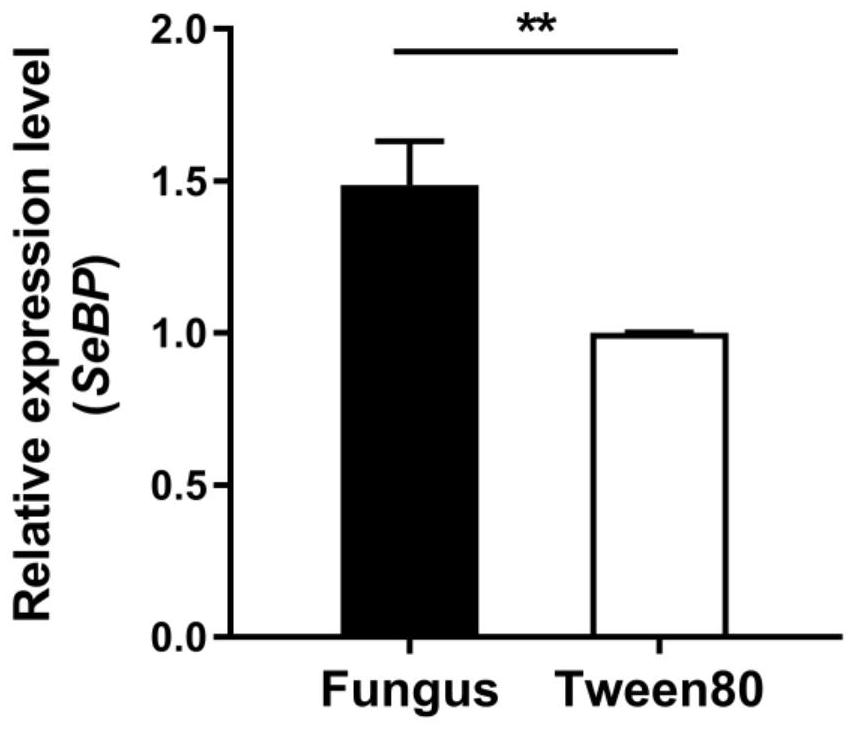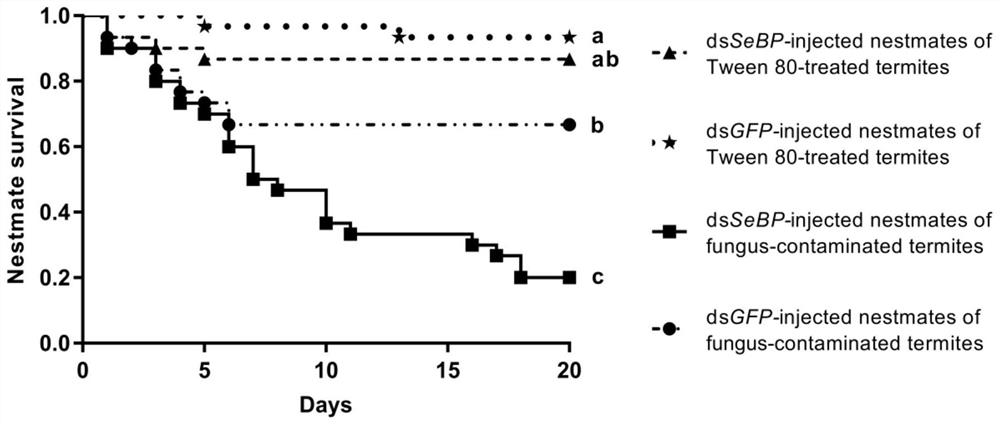Reticulitermes chinensis Snyder SeBP gene and application of combination of dsRNA of Reticulitermes chinensis Snyder SeBP gene and metarhizium anisopliae in termite control
A technology that combines proteins and termites, applied in DNA/RNA fragments, applications, genetic engineering and other directions, can solve the problems of reducing the control effect of Metarhizium anisopliae on termites, and the control effect of wild termites is not ideal, and achieves improved control effect and excellent effect. , a strong specific effect
- Summary
- Abstract
- Description
- Claims
- Application Information
AI Technical Summary
Problems solved by technology
Method used
Image
Examples
Embodiment 1
[0030] Embodiment 1: Obtaining the SeBP gene sequence of the termite termites
[0031] 1. Design the primers required for PCR amplification
[0032] Searched from the transcriptome database of Termites termites, and then used NCBI Nucleotide-BLAST to perform sequence alignment, and confirmed that a termite SeBP gene fragment was obtained. According to the SeBP gene fragment obtained by searching, the upstream primer CCACTCAGGATGGAACGTGT (SEQ ID No. 2) and the downstream primer GTCAGCGCCTGTATGGATCT (SEQ ID No. 3) were designed online using NCBIPrimer-BLAST. The designed primers were sent to Wuhan Qingke Biotechnology Co., Ltd. for synthesis.
[0033] 2. Prepare the template required for PCR amplification
[0034] Three mature worker ants with the same size and good growth conditions were selected and placed in a 2 mL centrifuge tube, placed in liquid nitrogen to rapidly cool the samples, and total RNA was extracted by the RNAiso Plus (Trizol) method. Then, referring to Prime...
Embodiment 2
[0037] Embodiment 2: Synthesis of the SeBP gene dsRNA of Termites black chest
[0038] 1. Primers required for the synthesis of dsRNA of the SeBP gene of Termites melanogaster
[0039] Based on the sequencing results of the nucleotide sequence SEQ ID No.1 of the SeBP gene of the termite termites, an upstream primer ACAAGCACGGAAATG GAAAG (SEQ ID No.4) and a downstream primer GGCTGCTTCCAGAGATGAAC (SEQ ID NO. No.5), the designed primers were sent to Wuhan Qingke Biotechnology Co., Ltd. for synthesis.
[0040] 2. Prepare the template required for SeBP gene dsRNA synthesis
[0041] The primers required for the dsRNA synthesis that all contain the T7 promoter are combined with the plasmid containing the SeBP gene for PCR amplification to obtain a DNA fragment that is 507bp in length, and its nucleotide sequence is as shown in SEQ ID No.6 (both ends Both contain the T7 promoter). The PCR product was purified by the method of phenol / chloroform / isoamyl alcohol (volume ratio 25:24:1)...
Embodiment 3
[0044] Embodiment 3: Detection of the interference effect of the SeBP gene dsRNA of Termites melanogaster
[0045] 1. Injecting termite SeBP gene dsRNA
[0046] Pick 30 mature worker ants with the same size and good growth condition for dsRNA injection. After the termites were anesthetized by freezing on ice, a volume of 100 nL and a total of 2 μg of dsRNA were injected into the intersegmental membrane between the second and third thoracic segments on the side of the thorax of the worker termites using a microinjector. Injected termites were reared in a 9cm-diameter petri dish, and the bottom of the petri dish was covered with wet filter paper as food. Fifteen termites injected with SeBP gene dsRNA (dsSeBP) were used as the treatment group, and 15 termites injected with the same amount of dsGFP were used as the control group.
[0047] 2. Detect termite SeBP gene fragment mRNA expression
[0048] Three days after dsRNA injection, three termites in good condition were selecte...
PUM
 Login to View More
Login to View More Abstract
Description
Claims
Application Information
 Login to View More
Login to View More - R&D
- Intellectual Property
- Life Sciences
- Materials
- Tech Scout
- Unparalleled Data Quality
- Higher Quality Content
- 60% Fewer Hallucinations
Browse by: Latest US Patents, China's latest patents, Technical Efficacy Thesaurus, Application Domain, Technology Topic, Popular Technical Reports.
© 2025 PatSnap. All rights reserved.Legal|Privacy policy|Modern Slavery Act Transparency Statement|Sitemap|About US| Contact US: help@patsnap.com



